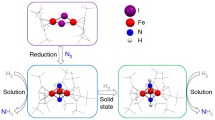Abstract
Products from the thermolysis of PhNCO and [MoO2(S2CNR2)2] (R = Me, Et) are highly dependent upon the reaction conditions. When carried out in air, the major products are cations, [Mo(NPh)(S2CNR2)3]+, as shown by a crystal structure of [Mo(NPh)(S2CNEt2)3]2[Mo6O19]. Under rigorously anaerobic conditions, reaction of two equivalents of PhNCO with [MoO2(S2CNR2)2] affords [Mo(NPh)2(S2CNR2)2] as the major product. However, chloroform solutions of the bis(imido) complexes hydrolyze in air to afford [Mo(NPh)(S2CNR2)2(μ-MoO4)]2, in which molybdate groups bridge between molybdenum(VI) imido-bis(dithiocarbamate) centers. These results are placed in context of our earlier studies of these reactions that lead to the formation of oxo-disulfide [MoS2(NPh)(S2CNR2)2] and dimeric molybdenum(V) [MoO(μ-NPh)(S2CNR2)]2 complexes, thus allowing a full picture of these transformations to be established.
Graphical Abstract
Heating PhNCO with [MoO2(S2CNR2)2] in air gives [Mo(NPh)(S2CNR2)3]X (R = Me, Et), but when the reaction is carried out under anaerobic conditions, [Mo(NPh)2(S2CNR2)2] initially results, chloroform solutions of which hydrolyze in air to afford [Mo(NPh)(S2CNR2)2(μ-MoO4)]2.





Similar content being viewed by others
References
Wigley DE (1994) Prog Inorg Chem 42:239
Green MLH, Hogarth G, Konidaris PC, Mountford P (1990) J Organomet Chem 394:C9
Green MLH, Hogarth G, Konidaris PC, Mountford P (1990) J Chem Soc Dalton Trans 3781
Kolomnikov IS, Koreshkov Yu D, Lobeeva TS, Volpin ME (1970) J Chem Soc Chem Commun 1432
Maatta EA (1984) Inorg Chem 23:2650
Nielson AJ (1986) Inorg Synth 24:194
Coffey TA, Forster GD, Hogarth G (1993) J Chem Soc Chem Commun 1524
Coffey TA, Forster GD, Hogarth G (1996) J Chem Soc Dalton Trans 183
Coffey TA, Forster GD, Hogarth G (1995) J Chem Soc Dalton Trans 2337
Hogarth G, Richards I (2005) Inorg Chim Acta 358:707
Forster GD, Hogarth G (1995) Polyhedron 14:1401
Barrie P, Coffey TA, Forster GD, Hogarth G (1999) J Chem Soc Dalton Trans 4519
Hogarth G, Richards I (2005) Dalton Trans 760
Minelli M, Le Hoang M, Kraus M, Kucera G, Loertscher J, Reynolds M, Timm N, Chiang MY, Powell D (2002) Inorg Chem 41:5954
Young CG, Boreham CJ, Broomhead JA (1983) J Chem Soc Dalton Trans 2135
Maatta EA, Wentworth RAD (1979) Inorg Chem 18:2409
Maatta EA, Wentworth RAD (1980) Inorg Chem 19:2597
Coffey TA, Forster GD, Hogarth G (1998) Inorg Chim Acta 274:243
Moore FW, Larson ML (1967) Inorg Chem 6:998
(2001) Area detector control and data integration and reduction software. Brüker AXS, Madison, WI
SADABS (1997) University of Göttingen, Göttingen, Germany
Sheldrick GM (1990) Acta Crystallogr Sect A 46:467
Sheldrick GM (1993) SHELXL, Program for crystal structure refinement. University of Göttingen, Göttingen, Germany
(2001) SHELXTL PLUS. Bruker AXS Inc., Madison, WI
Author information
Authors and Affiliations
Corresponding author
Rights and permissions
About this article
Cite this article
Hogarth, G., Richards, I. Molybdenum(VI) imido complexes: formation of [Mo(NPh)(S2CNR2)3]X and [Mo(NPh)(S2CNR2)2(μ-MoO4)]2 (R = Me, Et) from the reaction of [MoO2(S2CNR2)2] and PhNCO under aerobic conditions. Transition Met Chem 35, 111–115 (2010). https://doi.org/10.1007/s11243-009-9302-0
Received:
Accepted:
Published:
Issue Date:
DOI: https://doi.org/10.1007/s11243-009-9302-0



